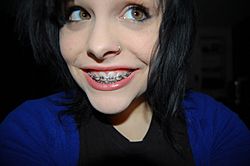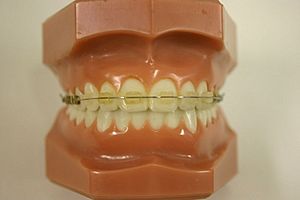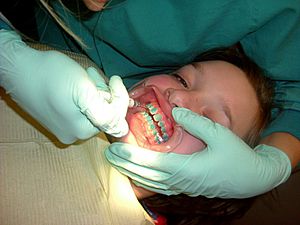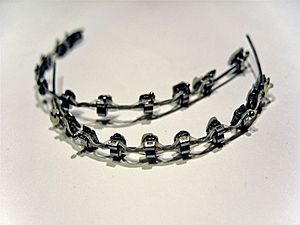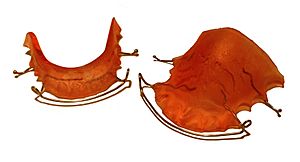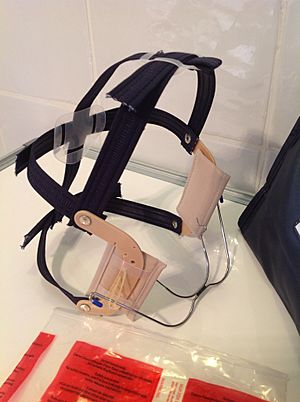Dental braces facts for kids
Dental braces are wires that are held together by brackets glued to the permanent teeth. The wires and brackets may be made of metal or other materials. Each week or month (or other time the orthodontist decides) the braces may be checked, cleaned, or changed into a tighter wire.
Braces are an orthodontic device. They are to make the teeth straight, and to correct problems in a person's bite. There are many natural problems which occur to the way teeth fit together, but not everyone needs or will need braces.
However, the use of braces is quite common, even when they are not medically necessary. Their cosmetic use for young females is more common in countries with first world economies. To overcome the visibility of traditional metal braces, there are now nearly transparent braces. Sometimes braces are possible behind the teeth, and so are not in view.
Contents
History
Ancient
According to scholars and historians, braces date back to ancient times. Around 400-300 BCE, Hippocrates and Aristotle contemplated ways to straighten teeth and fix various dental conditions. Archaeologists have discovered numerous mummified ancient individuals with what appear to be metal bands wrapped around their teeth. Catgut, a type of cord made from the natural fibers of an animal's intestines, performed a similar role to today’s orthodontic wire in closing gaps in the teeth and mouth. The Etruscans buried their dead with dental appliances in place to maintain space and prevent collapse of the teeth during the afterlife. A Roman tomb was found with a number of teeth bound with gold wire documented as a ligature wire, a small elastic wire that is used to affix the arch wire to the bracket. Even Cleopatra wore a pair. Roman philosopher and physician Aulus Cornelius Celsus first recorded the treatment of teeth by finger pressure. Unfortunately, due to lack of evidence, poor preservation of bodies, and primitive technology, little research was carried out on dental braces until around the 17th century, although dentistry was making great advancements as a profession by then.
18th century
Orthodontics truly began developing in the 18th and 19th centuries. In 1728, French dentist Pierre Fauchard, who is often credited with inventing modern orthodontics, published a book entitled "The Surgeon Dentist" on methods of straightening teeth. Fauchard, in his practice, used a device called a "Bandeau", a horseshoe-shaped piece of iron that helped expand the arch. In 1754, another French dentist, Louis Bourdet, dentist to the King of France, followed Fauchard's book with The Dentist's Art, which also dedicated a chapter to tooth alignment and application. He perfected the "Bandeau" and was the first dentist on record to recommend extraction of the premolar teeth to alleviate crowding and to improve jaw growth.
19th century
Although teeth and palate straightening and/or pulling was used to improve alignment of remaining teeth and had been practiced since early times, orthodontics, as a science of its own, did not really exist until the mid-19th century. Several important dentists helped to advance dental braces with specific instruments and tools that allowed braces to be improved.
In 1819, Delabarre introduced the wire crib, which marked the birth of contemporary orthodontics, and gum elastics were first employed by Maynard in 1843. Tucker was the first to cut rubber bands from rubber tubing in 1850. Dentist, writer, artist, and sculptor Norman William Kingsley in 1858 wrote the first article on orthodontics and in 1880, his book, Treatise on Oral Deformities, was published. A dentist named John Nutting Farrar is credited for writing two volumes entitled, A Treatise on the Irregularities of the Teeth and Their Corrections and was the first to suggest the use of mild force at timed intervals to move teeth.
20th century
In the early 20th century, Edward Angle devised the first simple classification system for malocclusions, such as Class I, Class II, and so on. His classification system is still used today as a way for dentists to describe how crooked teeth are, what way teeth are pointing, and how teeth fit together. Angle contributed greatly to the design of orthodontic and dental appliances, making many simplifications. He founded the first school and college of orthodontics, organized the American Society of Orthodontia in 1901 which became the American Association of Orthodontists (AAO) in the 1930s, and founded the first orthodontic journal in 1907. Other innovations in orthodontics in the late 19th and early 20th centuries included the first textbook on orthodontics for children, published by J.J. Guilford in 1889, and the use of rubber elastics, pioneered by Calvin S. Case, along with Henry Albert Baker.
Process
The application of braces moves the teeth as a result of force and pressure on the teeth. There are traditionally four basic elements that are used: brackets, bonding material, arch wire, and ligature elastic (also called an “O-ring”). The teeth move when the arch wire puts pressure on the brackets and teeth. Sometimes springs or rubber bands are used to put more force in a specific direction.
Braces have constant pressure which, over time, move teeth into the desired positions. The process loosens the tooth after which new bone grows in to support the tooth in its new position. This is called bone remodeling. Bone remodeling is a biomechanical process responsible for making bones stronger in response to sustained load-bearing activity and weaker in the absence of carrying a load. Bones are made of cells called osteoclasts and osteoblasts. Two different kinds of bone resorption are possible: direct resorption, which starts from the lining cells of the alveolar bone, and indirect or retrograde resorption, which takes place when the periodontal ligament has been subjected to an excessive amount and duration of compressive stress. Another important factor associated with tooth movement is bone deposition. Bone deposition occurs in the distracted periodontal ligament. Without bone deposition, the tooth will loosen and voids will occur distal to the direction of tooth movement.
When braces put pressure on teeth, the periodontal membrane stretches on one side and is compressed on the other. If this movement is not done slowly then the patient risks losing his or her teeth. This is why braces are commonly worn for a year or more and adjustments are only made every few weeks. A tooth will usually move about a millimeter per month during orthodontic movement, but there is high individual variability. Orthodontic mechanics can vary in efficiency, which partly explains the wide range of response to orthodontic treatment.
Types
- Traditional metal wired braces are stainless-steel and are sometimes used in combination with titanium. Traditional metal braces are the most common type of braces. These braces have a metal bracket with elastic (rubber band) ties holding the wire onto the metal brackets. The second-most common type of braces are self-ligating braces that do not require elastic ties. Instead, the wire goes through the bracket. Often with this type of braces, treatment time is reduced, there is less pain on the teeth, and fewer adjustments are required than with traditional braces.
- Clear braces serve as a cosmetic alternative to traditional metal braces by blending in more with the natural color of the teeth or having a less conspicuous or hidden appearance. Typically, these brackets are made of ceramic or plastic materials and function in a similar manner to traditional metal brackets. Clear elastic ties and white metal ties are available to be used with these clear braces to help keep the appliances less conspicuous. Alternately, clear braces can be self-ligating, meaning the wire clips into the bracket without the need for ligatures. Clear braces have a higher component of friction and tend to be more brittle than metal braces. This can make removing the appliances at the end of treatment more difficult and time consuming.
- Gold-plated stainless steel braces are often employed for patients allergic to nickel (a basic and important component of stainless steel), but may also be chosen because some people simply prefer the look of gold over the traditional silver-colored braces.
- Lingual braces are a cosmetic alternative in which custom-made braces are bonded to the back of the teeth making them externally invisible.
- Titanium braces resemble stainless steel braces but are lighter and just as strong. People with allergies to the nickel in steel often choose titanium braces, but they are more expensive than stainless steel braces.
- Multi-Loop Edgewise Archwire (MEAW Technique) therapy employs loops in the wire between teeth. This allows for more efficient vertical alignment of teeth and bite adjustment.
Traditional braces consist of a small bracket that is glued to the front of each tooth and the molars are adjusted with a band that encircles the tooth. An advantage is one can eat and drink while wearing the braces, but a disadvantage is that one must give up certain foods and eating habits while wearing them, such as gum with sugar and potato chips. Another disadvantage is they have to be periodically tightened by an orthodontist, causing increased amounts of discomfort.
- Customized orthodontic treatment systems (an example of which is SureSmile) combine high-technology including 3-D imaging, treatment planning software and a robot to custom bend the wire. Customized systems such as this offer faster treatment times and more efficient results. Customized orthodontic systems can also include lingual braces such as eBrace. Because the back surfaces of the teeth are more irregular, custom-made brackets can help to achieve a stronger bond between the tooth and bracket. Treatment with a customized brace can be more expensive and is not available at all orthodontists.
- Progressive, clear removable aligners (examples of which are Invisalign, Originator, and ClearCorrect) may be used to gradually move teeth into their final positions. Aligners are generally not used for complex orthodontic cases, such as when extractions, jaw surgery, or palate expansion are necessary. These braces are the most recent type of braces. Many orthodontists do not use these braces because they feel they do not produce the best corrective results compared to traditional braces, but opinions vary from person to person. This technique works by only tilting or rotating the teeth (including the roots), whereas traditional braces can parallel shift the whole tooth (including the roots). The braces are hardly noticeable on the teeth and work to gradually move the teeth into their right position without the need for wires or tightening. Like traditional braces, they do require an improvement in the amount of oral hygiene because they have to be removed to eat and one must brush and floss after every meal. Instead of using the traditional method where metal or clear braces were mounted for long periods of time, each set of aligners is worn for about 2 weeks, and they are removed to eat, drink, brush and floss. As the aligners are replaced every 2 weeks, the teeth are forced to move to fit the new mold. The total treatment time averages 9–15 months and the average number of aligners worn is between 18 and 30.
- For less difficult cases, spring aligners are also an option that can cost much less than braces or Invisalign (one example is NightShiftOrtho) and still align primarily the front six top and bottom teeth.
- Smart brackets are the latest concept under investigation. The smart bracket contains a microchip that measures the forces that act on the bracket and subsequently, the tooth interface. The aim of these braces is to reduce the duration of orthodontic therapy and the related expenses and discomfort to the individual.
- A-braces are another new concept in dental appliances. In the shape of a capital letter A, A-braces are applied, adjusted, removed and completely controlled by the user. At the ends of the A's arms are angled knobbed bits that the user bites down over. The width between the bits is adjusted by turning the crossbar, housed across the arms, outside the mouth. A user never has to experience pain because the pressure is so easy to control. Though they are not designed or recommended for wearing while sleeping, A-braces may serve as self-adjustable retainers and palate expanders. Partial braces cover only 4 front teeth and the 2 very back teeth. This is later upgraded to metal wire. 10 years is the minimum age to be able to receive this treatment.
Fitting procedure
Orthodontic services may be provided by any licensed dentist trained in orthodontics. In North America most orthodontic treatment is done by orthodontists, dentists in diagnosis and treatment of malocclusions—malalignments of the teeth, jaws, or both. A dentist must complete 2–3 years of additional post-doctoral training to earn a specialty certificate in orthodontics. There are many general practitioners who also provide orthodontic services.
The first step is to determine whether braces are suitable for the patient. The doctor consults with the patient and inspects the teeth visually. If braces are appropriate, a records appointment is set up where X-rays, molds, and impressions are made. These records are analyzed to determine the problems and proper course of action. The use of digital models is rapidly increasing in the orthodontic industry. Digital treatment starts with the creation of a three-dimensional digital model of the patient's arches. This model is produced by laser-scanning plaster models created using dental impressions. Computer-automated treatment simulation has the ability to automatically separate the gums and teeth from one another and can handle malocclusions well; this software enables clinicians to ensure, in a virtual setting, that the selected treatment will produce the optimal outcome, with minimal user input.
Typical treatment times vary from six months to two and a half years depending on the complexity and types of problems. Orthognathic surgery may be required in extreme cases. About 2 weeks before the braces are applied, orthodontic spacers may be required to spread apart back teeth in order to create enough space for the bands.
Teeth to be braced will have an adhesive applied to help the cement bond to the surface of the tooth. In most cases the teeth will be banded and then brackets will be added. A bracket will be applied with dental cement, and then cured with light until hardened. This process usually takes a few seconds per tooth. If required, orthodontic spacers may be inserted between the molars to make room for molar bands to be placed at a later date. Molar bands are required to ensure brackets will stick. Bands are also utilized when dental fillings or other dental work make securing a bracket to a tooth infeasible.
An archwire will be threaded between the brackets and affixed with elastic or metal ligatures. Ligatures are available in a wide variety of colors, and the patient can choose which color they like. Archwires are bent, shaped, and tightened frequently to achieve the desired results.
Modern orthodontics makes frequent use of nickel-titanium archwires and temperature-sensitive materials. When cold, the archwire is limp and flexible, easily threaded between brackets of any configuration. Once heated to body temperature, the archwire will stiffen and seek to retain its shape, creating constant light force on the teeth.
Brackets with hooks can be placed, or hooks can be created and affixed to the archwire to affix rubber bands to. The placement and configuration of the rubber bands will depend on the course of treatment and the individual patient. Rubber bands are made in different diameters, colors, sizes, and strengths. They are also typically available in two versions: colored or clear/opaque.
The fitting process can vary between different types of braces, though there are similarities such as the initial steps of molding the teeth before application. For example, with clear braces, impressions of a patient's teeth are evaluated to create a series of trays, which fit to the patient's mouth almost like a protective mouthpiece. With some forms of braces, the brackets are placed in a special form that are customized to the patient's mouth, drastically reducing the application time.
In many cases there is insufficient space in the mouth for all the teeth to fit properly. There are two main procedures to make room in these cases. One is extraction: teeth are removed to create more space. The second is expansion, in which the palate or arch is made larger by using a palatal expander. Expanders can be used with both children and adults. Since the bones of adults are already fused, expanding the palate is not possible without surgery to unfuse them. An expander can be used on an adult without surgery, but would be used to expand the dental arch, and not the palate.
Sometimes children and teenage patients, and occasionally adults, are required to wear a headgear appliance as part of the primary treatment phase to keep certain teeth from moving (for more detail on headgear and facemask appliances see Orthodontic headgear). When braces put pressure on one's teeth, the periodontal membrane stretches on one side and is compressed on the other. This movement needs to be done slowly or otherwise the patient risks losing his or her teeth. This is why braces are worn as long as they are and adjustments are only made every so often.
Braces are typically adjusted every three to six weeks. This helps shift the teeth into the correct position. When they get adjusted, the orthodontist removes the colored or metal ligatures keeping the archwire in place. The archwire is then removed, and may be replaced or modified. When the archwire has been placed back into the mouth, the patient may choose a color for the new elastic ligatures, which are then affixed to the metal brackets. The adjusting process may cause some discomfort to the patient, which is normal.
Post-treatment
Patients may need post-orthodontic surgery, such as a fiberotomy or alternatively a gum lift, to prepare their teeth for retainer use and improve the gumline contours after the braces come off.
Retainers
In order to prevent the teeth from moving back to their original position, retainers are worn once the treatment is complete. Retainers help in maintaining and stabilizing the position of teeth long enough to permit reorganization of the supporting structures after the active phase of orthodontic therapy. If the patient does not wear the retainer appropriately and/or for the right amount of time, the teeth may move towards their previous position. For regular braces, Hawley retainers are used. They are made of metal hooks that surround the teeth and are enclosed by an acrylic plate shaped to fit the patient's palate. For invisalign braces, an Essix retainer is used. This is similar to the regular invisalign braces; it is a clear plastic tray that is firmly fitted to the teeth, which stays in place without a plate fitted to the palate. There is also a bonded retainer where a wire is permanently bonded to the lingual side of the teeth, usually the lower teeth only. Doctors will sometimes refuse to remove this retainer, and a special orthodontic appointment to have it removed may be required.
Headgear
Headgear needs to be worn between 12–22 hours each day to be effective in correcting the overbite, typically for 12 to 18 months depending on the severity of the overbite, how much it is worn and what growth stage the patient is in. Typically the prescribed daily wear time will be between 14 and 16 hours a day and is frequently used post primary treatment phase to maintain the position of the jaw and arch.
Orthodontic headgear will usually consist of three major components:
- Facebow: first, the facebow (or J-Hooks) is fitted with a metal arch onto headgear tubes attached to the rear upper and lower molars. This facebow then extends out of the mouth and around the patients face. J-Hooks are different in that they hook into the patients mouth and attach directly to the brace (see photo for example of J-Hooks).
- Head cap: the second component is the headcap, which typically consists of one or a number of straps fitting around the patients head. This is attached with elastic bands or springs to the facebow. Additional straps and attachments are used to ensure comfort and safety (see photo).
- Attachment: the third and final component—typically consisting of rubber bands, elastics, or springs—joins the facebow or J-Hooks and the headcap together, providing the force to move the upper teeth, jaw backwards.
The headgear application is one of the most useful appliances available to the orthodontist when looking to correct a Class II malocclusion. See more details in the section Orthodontic headgear.
Images for kids
See also
 In Spanish: Aparatología fija para niños
In Spanish: Aparatología fija para niños


